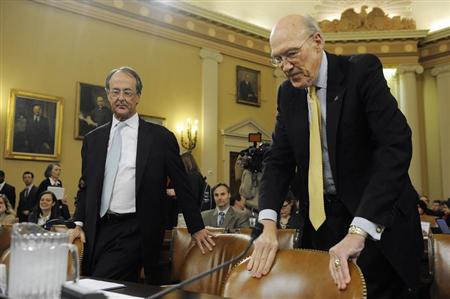Simpson, Bowles propose $2.4 trillion U.S. deficit reduction
Reuters – 5 hrs agoWASHINGTON (Reuters) - Two key deficit experts on Tuesday offered an updated plan to reduce U.S. government deficit spending by $2.4 trillion over 10 years through a combination of spending cuts, a healthcare overhaul and tax reform.
The proposal came from Erskine Bowles, a Democrat who served as President Bill Clinton's chief of staff, and former Republican senator Alan Simpson, the co-chairmen of a former fiscal commission that President Barack Obama launched during his first term. It adds to the Washington debate on what to do about $1 trillion in annual deficits and a $16 trillion national debt.
The Simpson-Bowles plan, a follow-up proposal that builds on the commission's 2010 report, comes as policymakers brace for automatic budget cuts that appear increasingly likely to kick in starting on March 1.
Simpson and Bowles both doubted Congress and the White House would be able to come up with a plan to avoid the cuts, known as sequestration.
It is unclear how much impact the plan will have because it contains elements that have been non-starters for each party - further tax revenue, which has been rejected by Republicans; and even deeper cuts to entitlement programs such as Medicare, a notion rejected by Democrats.
Under the proposal, about one-fourth of the $2.4 trillion in deficit reduction would come from healthcare reforms and another fourth from tax reform.
The remaining reduction would come from a combination of mandatory spending cuts, stronger caps on U.S. discretionary spending, using the Consumer Price Index for inflation-indexed provisions in the budget and lower interest payments.
"The proposal also calls for a parallel process to make Social Security sustainably solvent and further actions to bring transportation spending and revenues in line and limit per capita cost growth in federal budgetary commitment to healthcare to about the growth rate of the economy," according to a summary of the plan.
Overall, the plan seeks to keep the nation's debt under 70 percent of gross domestic product in a decade, and to keep lowering that ratio in the years after.
It quickly earned mixed reviews. The nation's largest labor union the AFL-CIO criticized the blueprint, calling it a blow to working Americans who would see their benefits cut.
The Campaign to Fix the Debt praised the framework for addressing major issues such as entitlement programs and tax reform, although it did not specifically endorse the plan.
"Their approach has the potential to refocus the national discussion back where it should be," said Maya MacGuineas, head of the non-partisan group aimed at improving the U.S. economy.
HEALTHCARE, TAXES
The initial Simpson-Bowles plan, released in December 2010 while head of Obama's bipartisan National Commission on Fiscal Responsibility and Reform, failed to gain enough support in Congress, although it has become the basis for much discussion.
Their latest proposal would target $600 billion in cuts over 10 years to the nation's healthcare system under Medicare and Medicaid insurance programs for the elderly, disabled and poor.
That is more than the $400 billion the Obama administration has said it would accept.
It calls for using so-called tax expenditures to help pay down the U.S. deficit, a move opposed by Republicans who want such expenditures to be used solely to lower tax rates.
It does not get specific, however, and tax expenditures include politically popular items like the tax break for mortgage interest and charitable giving.
"We're going to have to push the White House on healthcare, we're going to have to push the Republicans on revenue," Bowles said on CNBC.
"Over the next 10 years, there's probably $13 trillion worth of tax expenditures in the tax code ... and we're talking about using about $500 billion of that to reduce deficit and the rest they can use if they want to reduce rates," Bowles said. "I think that's a pretty fair trade."
He said the extra healthcare savings are necessary and would include more cost sharing and means testing as well as paying for quality of care provided, rather then the number of doctor's visits or tests - all ideas long-touted to curb the nation's rising healthcare costs, especially among Democrats.
In a nod to Republicans, however, the plan does not include vouchers or other means of helping people pay their premiums.
Still, Bowles and Simpson said it was unlikely either Republicans or Democrats would agree on a deal until after the harsh budget cuts kick in next Friday.
"I think when this really stupid, stupid, stupid sequester goes into effect and people have to start standing in lines for three hours to get through security at the airports, they're going to visibly feel how this government has become completely dysfunctional," Bowles told CNBC. "I think they will really get angry with these people in Congress and the administration.""
Simpson, who gave leaders on both sides a C-plus grade on handling the deficit, added: "It'll be chaos."
(Reporting by Steve Holland and Susan Heavey; Additional reporting by Kim Dixon; Editing by Doina Chiacu and Bill Trott)

No comments:
Post a Comment